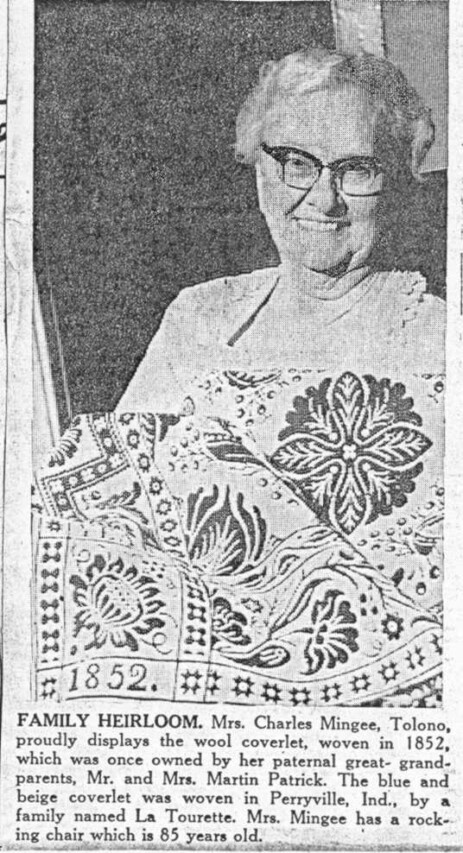MINGEE-Mary
Tolono - Mrs. Charles Mingee, Tolono, is the proud owner of a 117 year old coverlet that belonged to her paternal great-grandparents Mr. And Mrs. Martin Patrick. Mr. Patrick was born in New York in 1791. In 1828 he married the former Ruth Parent in what is now the Turkey Run neighborhood in Indiana. They started housekeeping west of Cayuga near the Little Vermilion River. Like all pioneers, they were self-sufficient, raising their own food and making their own clothing. They raised sheep for food and for wool from which yarn and cloth were woven. They also grew flax from which linen thread was woven. Both wool and linen were used for warmth and strength for the coverlets were used to keep warm during cold winter nights. Mrs. Mingee's great-grandparents gave each of their daughters a coverlet woven from the wool they had sheared from their sheep and the linen thread woven from flax they had raised in their fields. The blue and beige coverlet owned by Mrs. Mingee was woven in 1852 in Perrysville, Indiana by a family named LaTourette. They owned a loom and did weaving for the public. Mrs. Mingee's coverlet was given to her grandmother, Mrs. Mary Campbell Patrick, who in turn gave it to her daughter, Mrs. Effie Switzer. Mrs. Switzer lives near Perrysville, Indiana and will observe her 100th birthday August 22nd. Since Mrs. Switzer has no children she felt the coverlet should be handed down to another Mary Patrick. And that's how the 1852 coverlet came to be owned by Mrs. Mary Patrick Mingee. For Sarah LaTourette, Weaving was all in the Family From "ANTIQUE WEEK", Monday July 4, 1994, Vol. 27, No. 15 She's been called "the incomparable Sarah." Sarah LaTourette, the United States' only professional woman coverlet weaver, made as much a name for herself in the 19th century as she has with collectors today, who prize any LaTourette coverlet. Weaving was a family business for the LaTourettes, who trace their genealogy in the United States back to Jean LaTourette, a Huguenot refugee from France, who came to America in 1765. John LaTourette was born in New Jersey on Jan. 30, 1793. He married Sarah Schenck in Somerset, N.J., on Dec. 15, 1816, and the next day they began their journey westward. The couple settled in Germantown, Ohio, where the first seven of their 14 children were born. Among those children was Sarah, born in 1822. In 1828 John LaTourette decided to move west again. He walked across Ohio and much of Indiana, which was mostly virgin forest at that time. When he got to Fountain County in west-central Indiana, John bought 80 acres of land for $32.50 an acre, then hiked back to Ohio to get his family. As the LaTourettes settled on their property, they built a log cabin near Graham's Creek. The cabin served as their home until 1839, when a brick house was built on a hill above the creek. The house, considered by some to be a mansion, had a central hallway, wide fireplaces, paneled woodwork and "no two floors on the same level," according to one account. Once the house was occupied, the log cabin was moved up the hill and used as a loom house. The LaTourettes' weaving business was well established by the 1840s. The family made coverlets, blankets, diapers, jeans, flannel, carpet and twilled blankets. Their accounts book shows that charges ranged from $2 for a blanket to $5 for a coverlet. Other charges were $4 for 24 yards of jeans, $4 for 24 yards of broadcloth, and $3 for 12 yards of diapers. It is the family's coverlets, however, that are so desirable today. The LaTourettes wove double Jacquards in a variety of colors and patterns. Many of the coverlets used a border consisting of flowers and vines, a design that appears to be unique to their work. The family's trademark or signature block was created by John LaTourette. The following was excerpted from an interview with Schuyler LaTourette, a younger son who served as a captain with the 63rd Indiana Volunteer Infantry during the Civil War. He said: "Father was a weaver of all kinds of fabrics, from table linen to double coverlets. Mother did the coloring for our neighborhood. Barks of trees, plants, and roots were used. Black oak and bitter or red hickory were used for yellow. The roots of madder, a garden plant, colored the red. White walnut and butternut made a handsome brown, which became very unpopular in Indiana in Civil War days. Indigo was the base for many colors: the yellow, given a bath in indigo, gave green; the red in the same dye gave black. Sumac was much used by our mother to color wool blankets and boys' clothing. In the cabin, which still stands, Sister Sarah wove from morning till night; three looms were kept busy most of the time. I had to carry spools for my sister; who was such a fast weaver that she kept me very busy. I often think of those old days and our happy home, and how father taught his children and those of the neighborhood when a teacher could not be secured." John LaTourette died in 1849 leaving the family business to Sarah and her brother Henry, who was the only Indiana-born weaver (most professional weavers moved to Indiana from other states.) The brother and sister team made one notable change after their father's death - they added the word "YEAR" to the date in the signature block of most of their coverlets. A nephew once described Sarah as "six feet tall, a strapping Holland Dutch girl with long, strong arms." She was 27 when her father died, and had the professional and business skills needed to continue the business, Henry, who was 16, shared the work load with his sister. The family's account book shows that business remained steady until the Civil War. At that time, power looms made traditional weaving impractical and the LaTourettes' family business soon ended. The last coverlet known to have been woven by the LaTourettes was made by Henry in 1871. After the Civil War, the family split up. Schuyler returned from the war, married, and converted the old loom house into a honeymoon cottage. Sarah married John Van Sickle in 1870 and moved to Kentucky. Henry married Elizabeth Cooper in October 1872. Although Sarah moved out of state, she apparently retained strong feelings for Indiana. In Indiana Coverlet Weavers and Their Coverlets, Pauline Montgomery (1974, Hoosier Heritage Press) wrote, "At the end of a visit to his aunt in Kentucky, Sarah put in her nephew Fred's hands a beautiful coverlet in California Beauty (California roses) pattern saying, 'Here, take this back to Indiana where it belongs.' That coverlet, with one woven in 'Frenchman's Fancy' pattern by John and another, in 'Texas Star' pattern by Henry dated 1871, are in the possession of the family of Fred LaTourette (son of Captain Schuyler) 'where they belong'." Sarah died on June 4, 1914 at Cates Station, Ky. Her body was returned to Covington, IN, where she was buried in Mt. Hope Cemetery. Her father and Henry are also buried there.
File Created: By Nancy Lambert

Mary Mingee Champaign-Urbana, Illinois, News-Gazette


